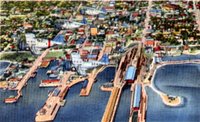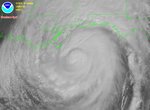Pensacola, Florida
|
|
This article is about the inland city of Pensacola, Florida. For the nearby beachside community, see Pensacola Beach, Florida. For other Pensacolas and Pensacola-related articles, see Pensacola.
Downtownpcola.jpg
Pensacola is a city located in Escambia County, Florida. As of the 2000 census, the city had a total population of 56,255; however, the greater Pensacola area is said to have an estimated population of nearly 500,000. It is the county seat of Escambia CountyTemplate:GR.
Pensacola is a sea port on Pensacola Bay, which connects to the Gulf of Mexico. A large United States Navy airbase is located southwest of Pensacola (near the community of Warrington) and is home to the Blue Angels flight demonstration team and the National Museum of Naval Aviation.
Pensacola is nicknamed "The City of Five Flags" due to the five flags that have flown over it at various times in its history: the flags of Spain, France, Great Britain, the Confederate States of America, and the United States.
Pensacola is served by Pensacola Regional Airport.
| Contents |
History
Spanish/French Phases
Pensacola was the first settlement of Europeans in what is now the United States. The area was first sighted by a European in 1513 by Spanish explorer Juan Ponce de Leon. Three years later, Don Diego Miruelo became the first European to sail into Pensacola Bay.
A settlement was founded in 1559 by Don Tristan de Luna and his party of about 1500 Spanish settlers. However, the settlement was destroyed by a major hurricane shortly afterwards, and was abandoned.
For this reason, many people instead regard St. Augustine, Florida as the first permanent European settlement in what would become the United States. The City of Pensacola, however, still occasionally refers to the area as "America's First Settlement" in advertisements and travel brochures.
The city and its bay were named after the Panzacola indians, a tribe that lived near the bay when the Spanish arrived. The name was changed to Pensacola to make it easier to pronounce for the Spanish. Despite the original settlement's destruction, the name was preserved and used when the area was re-settled during the 17th Century.
The area was first referred to as "Panzacola" in 1686. Previously, it was known as "Bahia Santa Maria de Filipina", as it was named so by Tristan de Luna when he founded the area's first settlement. "Panzacola" was affirmed as the area's name by a royal order of Spanish King Ferdinand VI in 1757.
The Spanish resettled Pensacola in 1698 under the direction of governor Andrés de Arriola. The French captured the settlement in 1719 and remained in control for three years. They burned the settlement on their retreat in 1722. The area was rebuilt, but ravaged by hurricanes in 1752 and 1761.
British Phase
Pensacola1885.jpg
At the close of the Seven Years' War (known in America as the French and Indian War) in 1763 the British took control of Pensacola. It is during the British occupation that the area began to prosper. Pensacola was made the capital of British West Florida and the town was laid out in its current form around the Seville Square district by surveyor and engineer Elias Durnford.
Spanish/American Phase
The Spanish recaptured Pensacola in 1781 and retained control (excepting three short-lived invasions by American General Andrew Jackson in 1813, 1814, and 1818) until 1821, when the Adams-Onís Treaty ceded all of Spanish Florida to the United States.
In 1825, the area for the Navy Yard was designated and Congress appropriated $6,000 for a lighthouse. The first permanent Protestant Christian congregation was established in 1827.
The Pensacola area is home to three historic U.S. forts, Fort Pickens, Fort Barrancas, and Fort McRee, as well as Barrancas National Cemetery. The city and Fort Barrancas were the site of the 1814 Battle of Pensacola. Fort Pickens was completed in 1834. It holds the distinction of being the only Southern fort not to be captured by the Confederacy in the American Civil War.
On 3 March 1845, Florida was admitted to the Union as the 27th state.
Confederate Phase
When Florida seceded from the Union on January 10th, 1861, remaining Union forces in the city evacuated to Fort Pickens. The Confederacy then held Pensacola until abandoning the city in May of 1862.
Florida was readmitted to the Union on 25 June 1868.
Other notable facts
From 1885 to 1887, the famous Apache Indian chief Geronimo was imprisoned in Fort Pickens, along with several of his warriors and their families. Fort Pickens is now a part of the Gulf Islands National Seashore, and as such, is administered by the United States Park Service.
Pensacola was the capital of Florida before Tallahassee became the capital.
Pensacola is home to a very large Jewish community, whose roots stretch back to the mid to late 1800s. The first Florida chapter of B'nai Brith was founded downtown in 1874, as well as the first temple, Beth-El, in 1876. Paula Ackerman, the first woman who performed rabbinical functions in the United States, was a Pensacola native and led services at Beth-El. Today, Pensacola has the second-largest concentration of Jewish people in the state, behind the South Florida metropolitan area.
Geography
Pensacola is located at 30°26'13" North, 87°12'33" West (30.436988, -87.209277)Template:GR.
According to the United States Census Bureau, the city has a total area of 102.7 km² (39.7 mi²). 58.8 km² (22.7 mi²) of it is land and 43.9 km² (17.0 mi²) of it is water. The total area is 42.77% water.
Hurricanes
Pensacola's location on the Florida Panhandle makes it vulnerable to hurricanes. Major hurricanes which have made landfall at or near Pensacola include Hurricane Juan (1985), Hurricane Opal (1995), and Hurricane Ivan (2004).
The Pensacola area was devastated by Hurricane Ivan. The hurricane either damaged or destroyed a large number of homes and businesses. Particularly hard-hit were the areas around Perdido Bay and Pensacola Beach. In addition, many of the area's bridges sustained structural damage. The hurricane disrupted public schools in Escambia County for nearly a month.
Demographics
FLMap-doton-Pensacola.PNG
Location of Pensacola, Florida
As of the censusTemplate:GR of 2000, there are 56,255 people, 24,524 households, and 14,665 families residing in the city. The population density is 956.8/km² (2,478.7/mi²). There are 26,995 housing units at an average density of 459.2/km² (1,189.4/mi²). The racial makeup of the city is 64.91% White, 30.58% African American, 1.77% Asian, 0.52% Native American, 0.06% Pacific Islander, 0.54% from other races, and 1.61% from two or more races. 2.07% of the population are Hispanic or Latino of any race.
There are 24,524 households out of which 24.6% have children under the age of 18 living with them, 39.7% are married couples living together, 16.7% have a female householder with no husband present, and 40.2% are non-families. 32.9% of all households are made up of individuals and 11.7% have someone living alone who is 65 years of age or older. The average household size is 2.27 and the average family size is 2.92.
In city the population is spread out with 22.9% under the age of 18, 8.9% from 18 to 24, 26.9% from 25 to 44, 24.0% from 45 to 64, and 17.2% who are 65 years of age or older. The median age is 39 years. For every 100 females there are 88.5 males. For every 100 females age 18 and over, there are 84.7 males.
The median income for a household in the city is $34,779, and the median income for a family is $42,868. Males have a median income of $32,258 versus $23,582 for females. The per capita income for the city is $21,438. 16.1% of the population and 12.7% of families are below the poverty line. Out of the total population, 26.2% of those under the age of 18 and 9.2% of those 65 and older are living below the poverty line.
Local media
The largest daily newspaper in the area is the Pensacola News Journal. Pensacola is also home to WEAR-TV, the ABC affiliate for Pensacola, Mobile, Alabama, and Fort Walton Beach, Florida, and WSRE-TV, the local PBS affiliate, which is operated by Pensacola Junior College. Other major networks are broadcast from nearby Mobile, such as CBS affiliate WKRG, NBC affiliate WPMI, and FOX affiliate WALA.
Local schools and libraries
Public schools in Pensacola are administered by the Escambia County School District.
Universities and colleges
- University of West Florida (appx. 9,500 students)
- Pensacola Junior College (appx. 6,000 students)
- Pensacola Christian College (appx. 5,000 students)
Area high schools
- Pensacola High School [1] (http://www.pensacolahighschool.org/) (appx. 1,680 students)
- Escambia High School [2] (http://www.escambia.k12.fl.us/schscnts/esch/) (appx. 1,900 students)
- Booker T. Washington High School [3] (http://www.escambia.k12.fl.us/schscnts/wash/btwhome.htm) (appx. 1,770 students)
- Tate High School [4] (http://www.escambia.k12.fl.us/schscnts/tath/)
- Woodham High School [5] (http://www.woodhamhighschool.com/)
- Pine Forest High School [6] (http://www.pfhseagles.com/) (appx. 1,700 students)
- West Florida High School of Advanced Technology [7] (http://www.wfhs.net/)
Libraries
- West Florida Regional Library System — approximately 360,000 books, 36,000 audio documents, and 14,000 video documents
- The University of West Florida has a separate library, the John C. Pace library.
Branches
- Pensacola Public Library — downtown Pensacola
- Lucia M. Tryon Branch Library — on the Pensacola Junior College campus
- Southwest Branch Library — in southwest Pensacola, near Perdido Key
- The West Florida Regional Library System also has four branches in Santa Rosa County, Florida.
Local hospitals
- Baptist Hospital
- Sacred Heart Hospital
- West Florida Hospital
- Naval Hospital Pensacola
- Nemours Children's Clinic
Sports teams
Pensacola is home to several semiprofessional sports teams:
- The Pensacola Ice Pilots of the East Coast Hockey League
- The Pensacola Pelicans of the Central Baseball League
- The Pensacola Aviators of the American Basketball Association (expansion team; set to begin play in 2005 or 2006)
- The Pensacola Power of the National Women's Football Association
Famous Pensacolians
- Paula Ackerman
- Jay Bell
- Neal Boortz
- Derrick Brooks
- Joe Durant
- Justin Gatlin
- General Daniel "Chappie" James Jr.
- Roy Jones, Jr.
- Fred Levin
- Dot Moore
- Joe Scarborough
- Emmitt Smith
- Michelle Snow
Famous visitors
Pensacola was visited by President George W. Bush, the first President to visit the area since his father. It was first visited by the President on 10 August 2004, then once after Hurricane Ivan to survey the damage. George W. Bush returned — with his mother — for the third time to Pensacola on 18 March 2005 to hold a town hall meeting at Pensacola Junior College about his plans for Social Security.
External links
- City of Pensacola official website (http://www.ci.pensacola.fl.us/)
- Pensacola Bay Area Convention & Visitors Bureau (http://www.visitpensacola.com/)
- Pensacola Area Chamber of Commerce (http://www.pensacolachamber.com/)
- Pensacola Historical Society website (http://www.pensacolahistory.org/)
- Pensacola after Hurricane Ivan (http://earthobservatory.nasa.gov/NaturalHazards/natural_hazards_v2.php3?img_id=12452) from a NASA website
- National Museum of Naval Aviation (http://naval.aviation.museum/intro.html)


